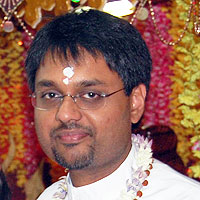From a satsang with Pt. Dr. Umesh Persad, SWAHA
As we celebrate the beautiful festival of Divali this month, our hearts and homes are adorned with the warm glow of numerous deeyas, symbolising both light and spirituality. Divali is a time to reflect on the divine presence of Lakshmi Maa, who embodies both material and spiritual wealth. Spiritual wealth often grows in significance over time, whereas material wealth may fluctuate with the fortunes of circumstance.
Spiritual wealth encompasses the mastery of our mind and senses, the ability to detach from the distractions of the external world, patience, single-minded focus, and a faith that harmonises knowledge and belief. When these internal deeyas are kindled, we become spiritually enriched, not only in this life but also in the eternal journey beyond. Armed with such spiritual wealth, we can face life’s challenges with tranquillity and a settled mind.
Diwali is a festival often associated with the revered figures of Lakshmi Maa and Shree Ram. Ram, in its essence, means “that which shines within”. If we close our eyes and envision these deeyas within, we can ponder upon the question: Who is the observer of these divine lights within us? The answer lies with Bhuvaneshwari Maa, the space within our own consciousness. By quieting our minds, we can encounter the divine light, spaciousness and awareness that perpetually resides within us. These six spiritual lights are also akin to the seven primary energy vortices, or chakras, within the human body.
The question arises, how do we prepare ourselves to experience the divinity within? In the Devi Gita, Himalay sought this very wisdom from Devi herself, the Supreme Energy underlying all creation. She outlined three pathways to liberation: karma yoga (the path of action), gyaan yoga (the path of knowledge), and bhakti yoga (the path of devotion). In essence, yoga signifies “union”, i.e., the union of the individual soul with the Supreme Soul. Yet, it is crucial to recognise that the illusion of separateness between the individual and the Divine must be dispelled. Our journey toward divinity is a realisation that the divine union is intrinsic and eternal.
Devi elucidates that these three paths are, in truth, a single road with three distinct names. Whether through knowledge, devotion or action, they all lead to the same divine destination. Each of us, driven by our unique temperaments and characters, seeks to transcend the confines of our own minds in our quest to discover our true selves. Nonetheless, Devi advises that the path of bhakti yoga is the simplest and most accessible.
She reveals to Himalay that there are four types of bhakti:
- Tamas bhakti: The lowest form, characterised by worship with harmful intentions toward others.
- Rajas bhakti: Worship driven by self interest, seeking personal gain or problem solving.
- Sattva bhakti: Worship with a desire to purify one’s sins, offering the results of actions to the Divine. However, a sense of separateness still remains.
- Paraa bhakti: The highest form of worship, where there is a profound unity between the worshipper and the worshipped. Devotees of this path identify with Devi Maa as their very essence. It is the ultimate realisation that the one who prays and the one who listens are one and the same, an unwavering awareness that we are far more than our limited personalities.
May this Divali guide all devotees on their spiritual journeys, helping them discover the radiant light within their own selves.




Jamie
This section delves into the individual’s personal spiritual beliefs and practices, regardless of affiliation with a specific religion.